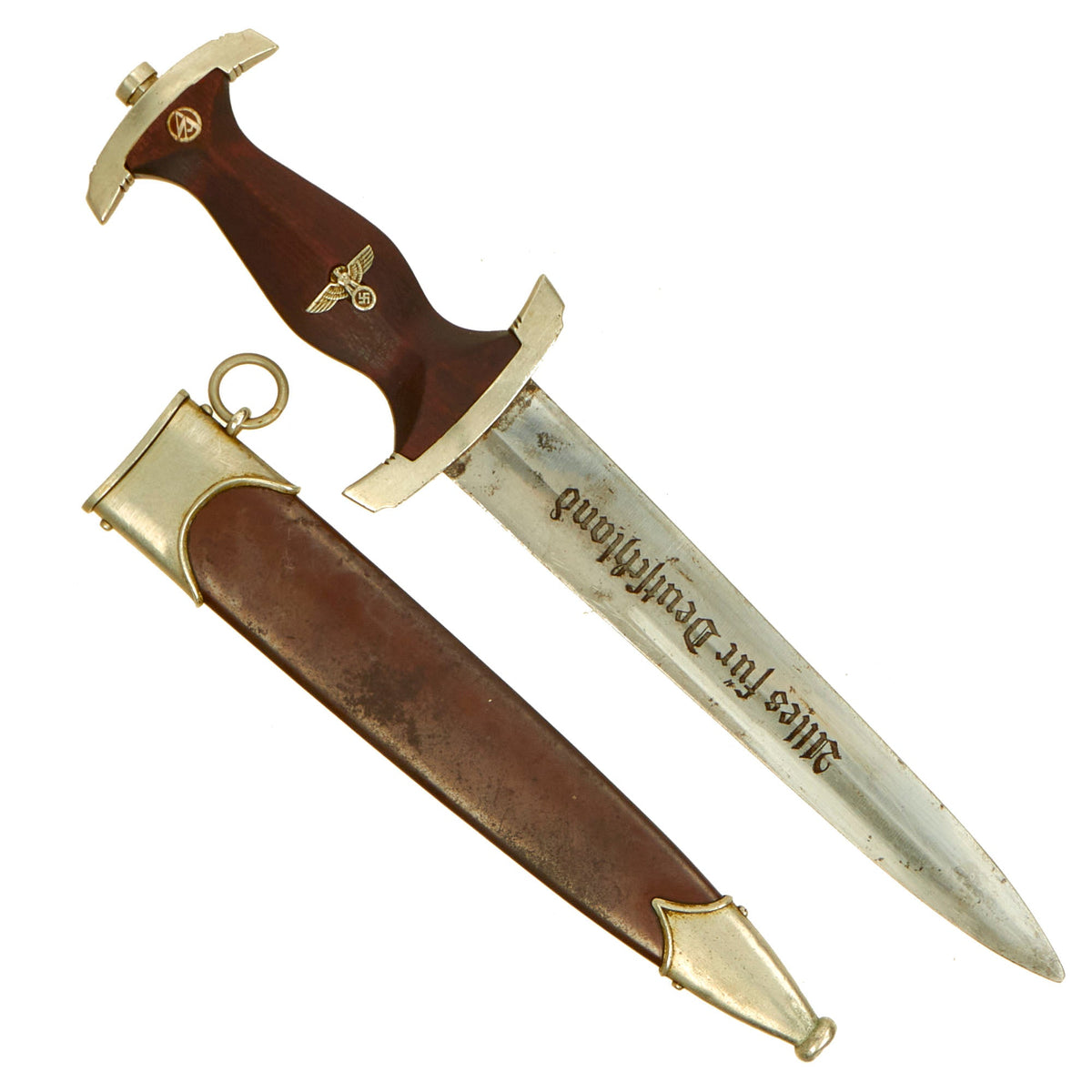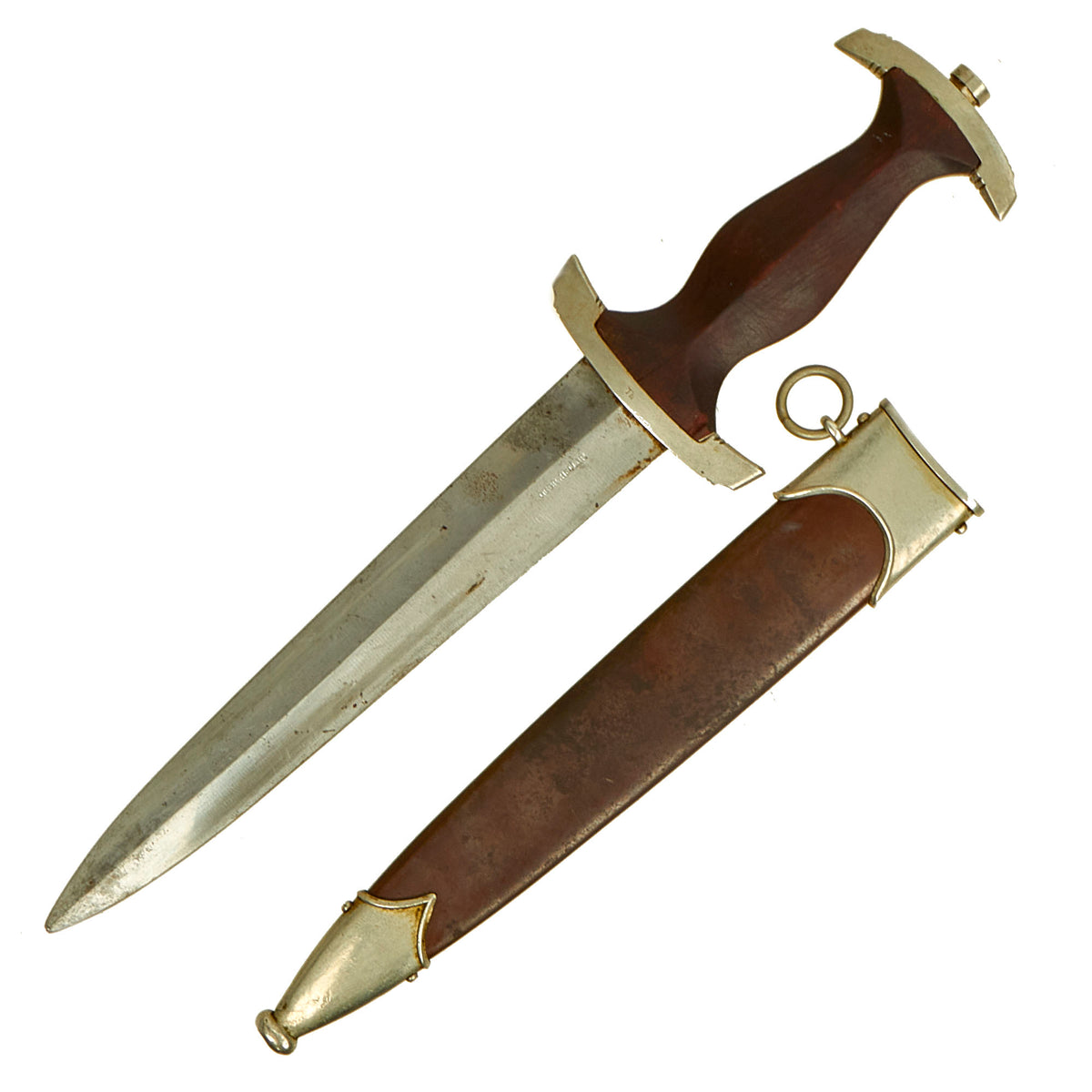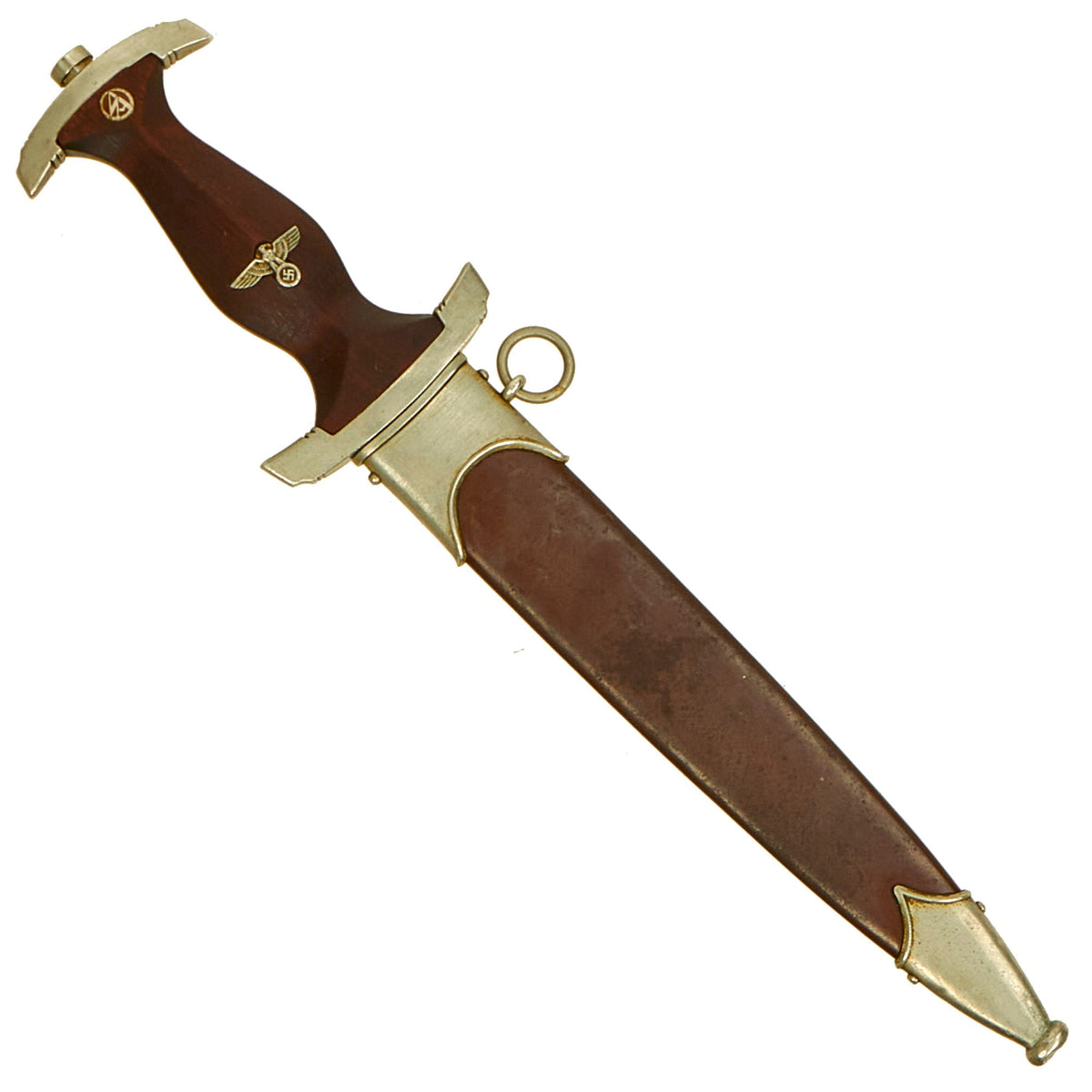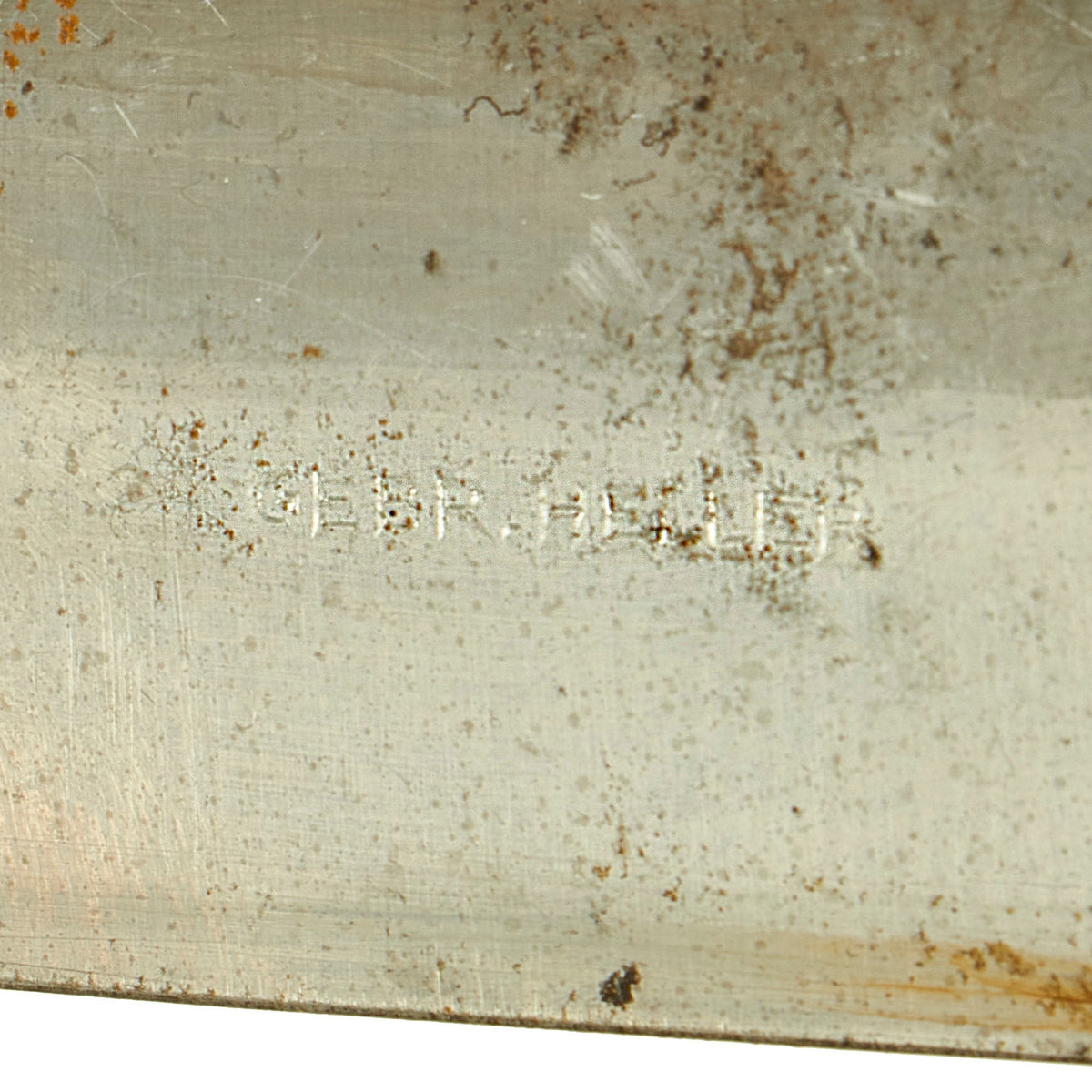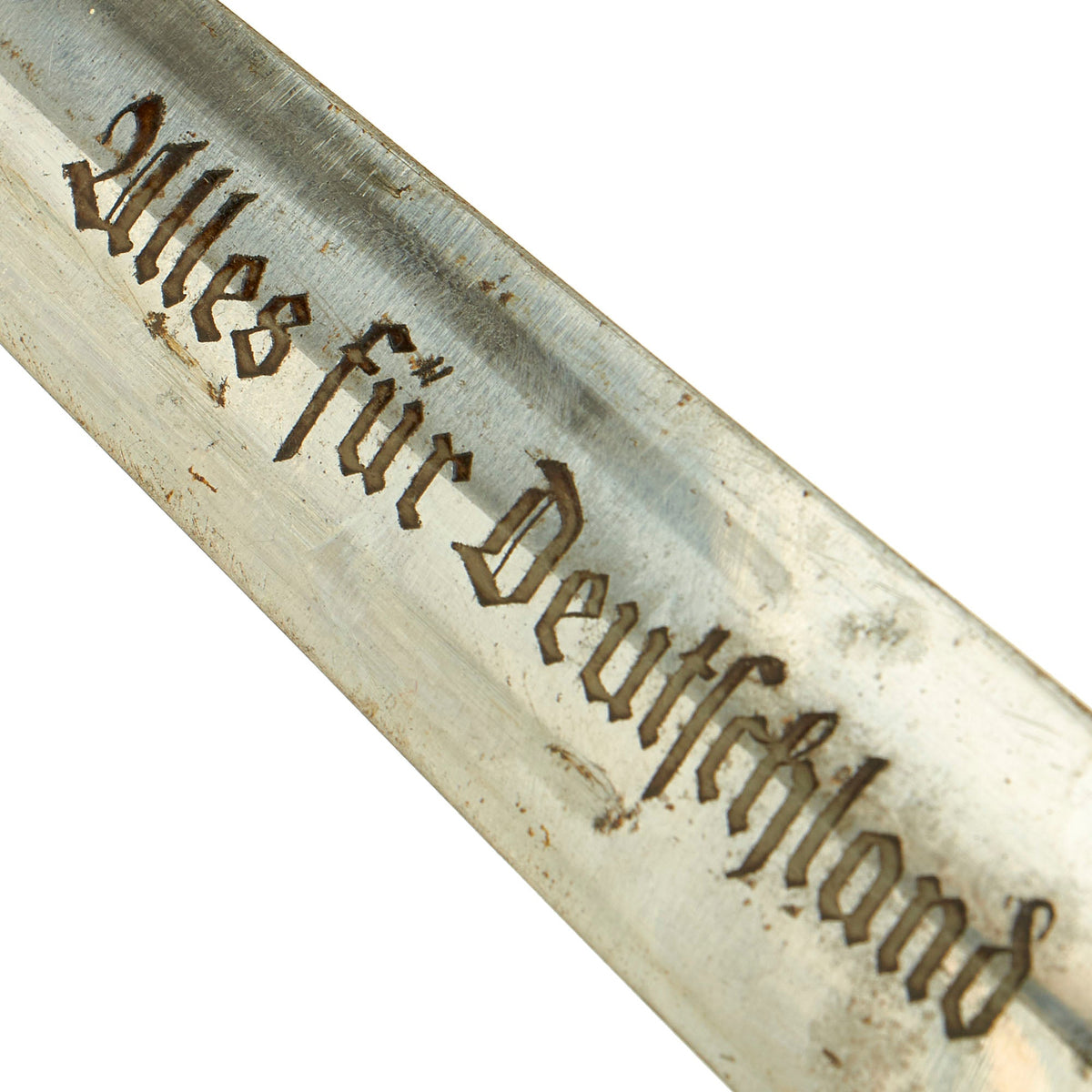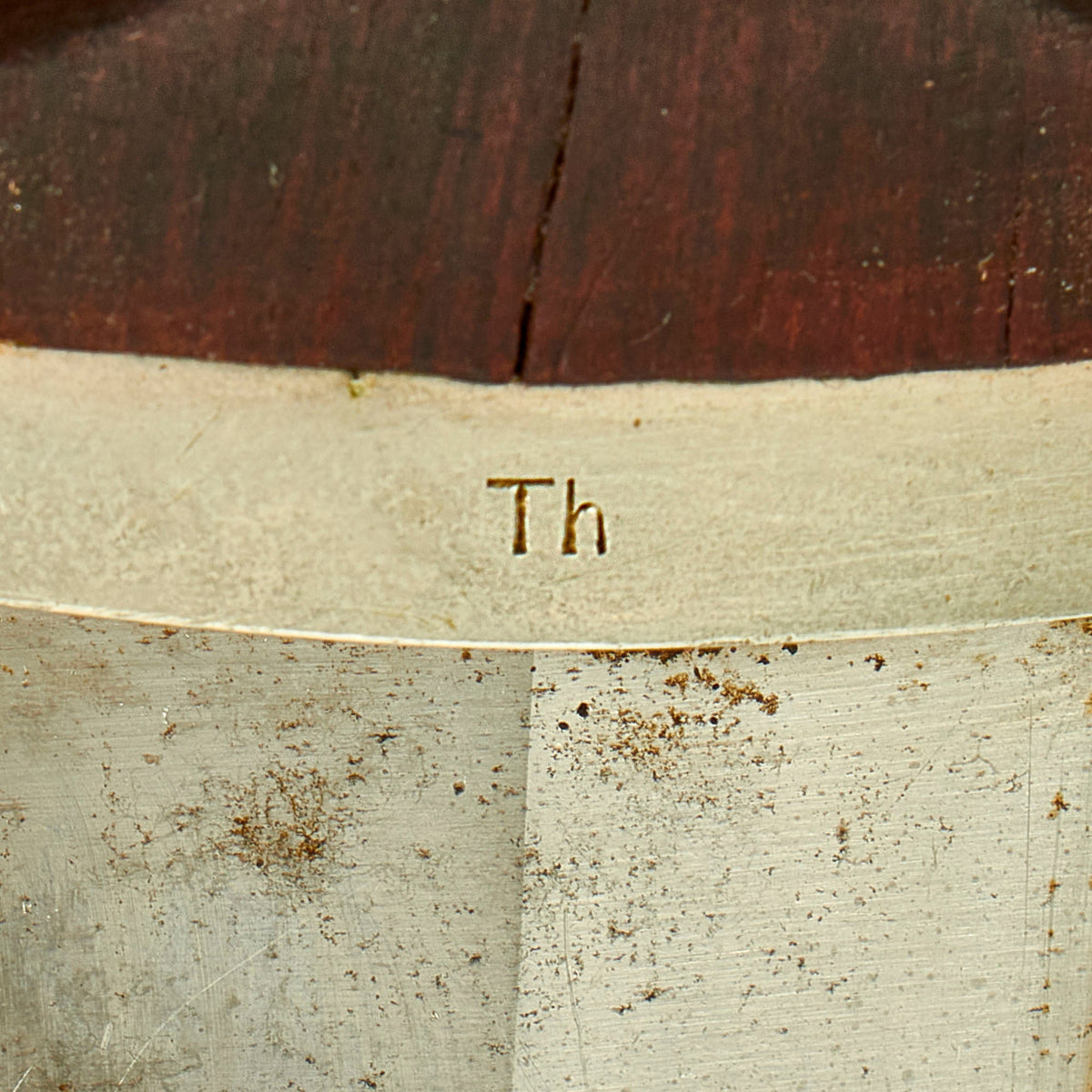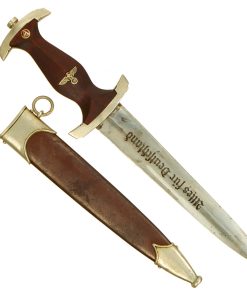Original German Early WWII SA Dagger by Gebrüder Heller of Marienthal with Scabbard – Vertical Name Original Items
$ 895,00 $ 223,75
Original Item: Only One Available. This is a great early pattern SA Dagger, made by the somewhat rare maker Gebrüder Heller GmbH, Stahlwarenfabrik, located in Marienthal, Germany. We have only had a few examples of edged weapons of any type by this maker. The dagger comes complete with its original early pattern scabbard, which is in very nice shape.
The dagger has solid nickel silver fittings throughout, and is a really nice example. The cross guards and tang nut are in very good condition throughout with all fittings having a nice lightly aged patina. The lower reverse guard is Gruppe/Gau marked Th, for Thüringen (Thuringia), a district in central Germany, with the principal cities being Weimar and Erfurt. This feature was only seen on daggers produced 1935 and prior. The nickel alloy end nut shows only a bit of turning, and the hilt is solid on the tang.
The grip is a fine product having a lovely dark red mahogany brown brown color, with a medium center ridge construction. It looks to have seen cleaning and oiling over the years, which has made the color a bit darker than normal. There is some cracking near both the cross and pommel guards, with a small chunk missing near the rear cross guard. It also shows a few dents, but no other damage to note. The grip fits the crossguards nicely, with no wobble we can feel. The SA symbol button is nicely set, and still has most of the translucent enamel intact, with some areas a bit worn. There is a bit of oxidation surrounding the emblem. The grip eagle is a fine example being the style with beak that points straight. Most of the details are still there to the eagle to include the beak, breast feathering, wing feathering, talons, wreath and mobile swas. There is a bit of wear as well as more verdigris oxidation, showing that is the correct solid nickel silver for an early pattern eagle.
The blade of this example is in very good condition, with the factory final grind cross grain retained throughout the blade! This texture is iconic, and is the definitive identifying characteristic for a real WWII German Blade. There is however also some evidence of edge sharpening after it left the factory, and there also are some areas of oxidation staining. There are some scuff marks in areas, and there is the usual wear from the scabbard runners, present on just about every German dagger out there. The dagger is missing a small chip at the tip, and had the area slightly re-profiled. The acid-etched Alles für Deutschland (Everything for Germany) SA motto is crisp, retaining about 75% of the factory darkening, however there is also some oxidation staining as well.
This fine example was produced by the somewhat rare maker Gebrüder Heller GmbH, Stahlwarenfabrik (Steelware Factory), and is marked with their simplified “Vertical Name” trademark logo on the rear ricasso:
GEBR. HELLER
This company was located in Marienthal bei Schweina in Thüringen, Germany, and was founded in the early 20th century, though the shops origins trace back to the late 19th century. They manufactured edged weapons for Germany during WWI and WWII, and had a satellite drill bit company in Schmalkalden. They manufactured some SA and NSKK daggers with the “Vertical Name” as seen on this example. For more information, please see J. Anthony Carter’s fine work GERMAN SWORD AND KNIFE MAKERS.
The scabbard shell is straight throughout and is the early-war style, which were produced with a brown “anodized” finish on the steel, which was then lacquered. This example has lost almost all of the lacquer overall, with just a bit retained around the fittings. However, it still retains most of the anodized finish on both sides, with just a few small dents. There is some staining and oxidation spots on the reverse. The upper and lower fittings are solid nickel silver, with a great look and some dents and scratches showing typical wear. The chape is a bit dented at the end, as the nickel alloy is somewhat soft, making this a common thing to see. The throat nicely matches the crossguards, and all four of the original dome head screws are present.
A great early war SA dagger by a desirable maker, complete with a very nice scabbard. Ready to display!
Specifications:
Blade Length: 8 3/4″
Overall length: 13 3/4”
Crossguard: 3”
Scabbard Length: 10”
History of the SA-
The SA or Brown Shirts, were a private political formation which Adolf AH and the NSDAP used to maintain order at organized Party meetings and demonstrations. The group was formed in 1921, and grew to a huge force of nearly 3,000,000 men by the later 1930’s. To instill esprit de corps, as well as create employment for the Blade City of Solingen, it was decided each SA man would carry a dagger with his Brown Shirt uniform. Huge quantities needed to be produced to accommodate the demand. The dagger initially was produced of hand-fitted nickel mounts with attractive finished wood grip and brown anodized (a bluing process) finished scabbard.
The blade was etched with the SA motto, Alles für Deutschland. Examples produced prior to 1935 were stamped with the German sector of the SA group on reverse lower crossguard. Later examples underwent standardization through the RZM ministry. These pieces were produced of cheaper plated zinc-base fittings and scabbards were simply painted brown.
Prior to his “unmasking” as a traitor, Ernst Röhm was the leader of the SA. In 1934, he distributed approximately 100,000 SA daggers with his personal inscription on the reverse blade. These daggers were to honor individuals who had served with the SA prior to December, 1931. Other than the inscription, these pieces were identical to the standard M1933 SA dagger. After the Röhm purge, the inscription was ordered to be removed. Many examples were returned to the factory for grinding. Others were simply ground in the field by whatever means were available. Examples will occasionally be encountered with remnants of the original inscription remaining on the blade, but mostly none will remain. Some blades exist with an intact inscription, reflecting only the removal of the Röhm signature. Very very rarely is an example seen with a full, untouched inscription, as the holder would have surely risked a charge of treason.
Fast Shipping with Professional Packaging
Thanks to our longstanding association with UPS FedEx DHL, and other major international carriers, we are able to provide a range of shipping options. Our warehouse staff is expertly trained and will wrap your products according to our exact and precise specifications. Prior to shipping, your goods will be thoroughly examined and securely secured. We ship to thousands clients each day across multiple countries. This shows how we're dedicated to be the largest retailer on the internet. Warehouses and distribution centres can be located throughout Europe as well as the USA.
Note: Orders with more than one item will be assigned a processing date depending on the item.
Before shipping before shipping, we'll conduct a thorough inspection of the items you have ordered. Today, the majority of orders will be delivered within 48 hours. The delivery time will be between 3-7 days.
Returns
The stock is dynamic and we cannot completely manage it because multiple stakeholders are involved, including our factory and warehouse. So the actual stock may alter at any time. It's possible that you may not receive your order once the order has been made.
Our policy is valid for a period of 30 days. If you don't receive the product within 30 days, we are not able to issue a refund or an exchange.
You can only return an item if it is unused and in the same state as the day you received it. You must have the item in its original packaging.
Related products
Uncategorized
Uncategorized
Uncategorized
Uncategorized
Uncategorized
Uncategorized
Uncategorized
Uncategorized
Uncategorized
Uncategorized
Armoured Fighting Vehicles of the World: AFVs of World War One (Hardcover Book) New Made Items
Uncategorized
Australian WWII Owen MK1 Machine Carbine SMG Custom Fabricated Replica with Sling Original Items
Uncategorized
Angolan Rebel 1970s era 60mm Inert Display Mortar from Angolan Civil War Original Items
Uncategorized
Uncategorized
Uncategorized
Uncategorized
Uncategorized
Uncategorized
